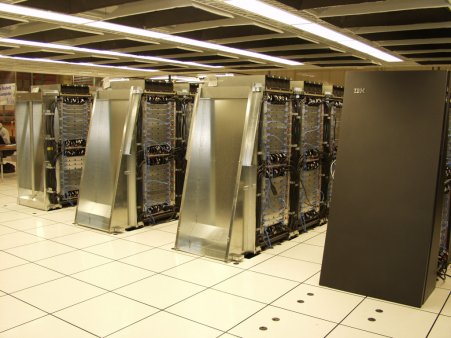Quarter-sized BlueGene/L doubles supercomputing record
Nov 5, 2004 — by Henry Kingman — from the LinuxDevices Archive — views BlueGene/L, the revolutionary IBM supercomputer based on embedded processor technology, has set another supercomputing record. Although only a quarter complete, BlueGene/L has turned in a LINPACK benchmark result that nearly doubles a previous supercomputing record that stood for three years.
BlueGene/L, the revolutionary IBM supercomputer based on embedded processor technology, has set another supercomputing record. Although only a quarter complete, BlueGene/L has turned in a LINPACK benchmark result that nearly doubles a previous supercomputing record that stood for three years.

The BlueGene/L, 25 percent complete, is already the supercomputing champ, the DOE says
(Click to enlarge)
BlueGene/L first made the Top 100 supercomputer list when it was only a prototype little bigger than a 30-inch television, ranking 73rd. Now, according to US Secretary of Energy Spencer Abraham, BlueGene/L has turned in a performance of 70.72 teraFLOP/s (trillion floating point operations per second) on the industry standard LINPACK benchmark, nearly doubling the 35.86 teraFLOPS mark set by the Japanese Earth Simulator in Yokohama, Japan, a result that stood for nearly three years before being edged past by BlueGene/L in September.
BlueGene/L is the product of a multi-year research and development partnership between IBM and the US Department of Energy's (DOE's) National Nuclear Security Administration (NNSA). BlueGene/L will be used by the NNSA's Stockpile Stewardship Program to “ensure the safety, security, and reliability of the nation's nuclear weapons stockpile without underground nuclear testing,” according to today's press release from the DOE.
Secretary Abraham said, “The delivery of the first quarter of the BlueGene/L system to Lawrence Livermore National Laboratory this month shows how a partnership between government and industry can effectively advance national agendas in science, technology, security, and industrial competitiveness. High performance computing is the backbone of the nation's science and technology enterprise, which is why the Department has made supercomputing a top priority investment. Breakthroughs in applied scientific research are possible with the tremendous processing capabilities provided by extremely scalable computer systems such as BlueGene/L.”
BlueGene/L uses low-power dual-core PowerPC embedded processors that run a Linux-like operating system, in conjunction with control nodes that run Linux. For a complete overview of BlueGene/L technology, and the role of Linux, be sure to read our look inside Bluegene.
Scientific problems in chemistry, physics, and materials science require an immense processing capability but frequently present relatively modest memory requirements. For NNSA and its Advanced Simulation and Computing program, the BlueGene/L machine is essential for understanding pressing scientific issues including, most prominently, weapons aging. Additionally, understanding material properties, higher resolution representations of physics in three-dimensions, and achieving a tighter coupling of computational science with experimental science are all issues that the BlueGene/L architecture is uniquely qualified to support through large-scale calculations, according to the DOE.

The BlueGene/L has lower power, space, and cooling requirements than other supercomputers
(Click to enlarge)
Secretary Abraham added “BlueGene/L will reduce the time-to-solution for many computational problems, allowing DOE scientists to explore larger, longer, and more complex problems than ever before. For example, a heroic thirty-day calculation on what was the Number 3 supercomputer on the Top 500 list in summer of 2003 would now be completed on this quarter-size BlueGene/L system in about three days.”
According to the DOE, the final BlueGene/L system will exceed the performance of the Japanese Earth Simulator by a factor of about nine, while requiring one-seventh as much electrical power, and one-fourteenth the floor space. Lower resource requirements, and higher performance, will avail more university, government, and industry researchers of supercomputer access.
This article was originally published on LinuxDevices.com and has been donated to the open source community by QuinStreet Inc. Please visit LinuxToday.com for up-to-date news and articles about Linux and open source.